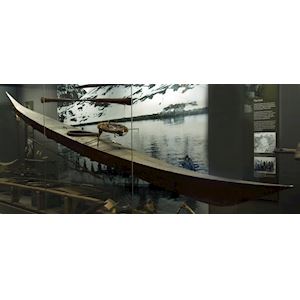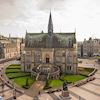
22. INUIT COLLECTIONS AND WHALING INDUSTRY IN DUNDEE AND THE WORLD
As whaling ships travelled north in their pursuit of whales, they came into contact with the native peoples of the Arctic. Most of the Inuit objects in this display were acquired during the height of the Dundee whaling industry. By the 1860s, around 500 Dundee men were fishing in the Arctic waters. The sailors traded with the Inuit. They would barter for everyday items - including tools used for hunting and fishing, as well as implements used for preparing food – which they brought back to Scotland. Look for the 1886 photograph of Urio Atwange on the main graphic panel on the right, Through their interaction with the whalers, the Inuit became curious about Scotland. Between 1873 and 1924, a number of Inuit men travelled to Dundee on whaling boats. They stayed here until the boats returned to the Arctic the following season. We don’t know much about Urio Atwango, but because this photograph was taken in a Dundee studio, we believe he travelled to the city on a whaling ship. Object numbers 32 and 33 in this display are dolls. They were traditionally made by young Inuit girls to learn the process of sewing skins. Originally made as toys, dolls became sought after as collectors' items because of how accurately they depict regional costume. Over time, the dolls gradually became more elaborate. Now look for object number 18 in this case. This kayak was constructed of a frame of whale baleen or driftwood tied together and covered in sealskins. It was built for one person and propelled by a double-bladed paddle. Kayaks like this were used in the summer to transport Inuit to the next hunting grounds, or sometimes to hunt walruses or even whales. All of the objects in this display are part of The McManus’ nationally significant whaling industry collection. You can see more of this collection in the Making of Modern Dundee gallery downstairs. When you’re ready, please walk to your right, to look at the Egyptian display.


The McManus: Dundee's Art Gallery and Museum
The McManus: Dundee’s Art Gallery and Museum is situated in the centre of Dundee. The Museum and Art Gallery originally known as the Albert Institute was opened in 1867 as a memorial to Prince Albert. In 2005 The McManus closed for a major refurbishment, reopening again on the 28th February 2010. We celebrated our 150th Anniversay in 2017 with a year of celebration. In 2020 we were awarded Visitor Attraction of the Year by Visit Scotland. The McManus has 8 galleries, which are laid out on 2 floors. Visitors can embark on a journey through 400 million years, and witness how a small settlement developed into the City of Dundee as it is today. From exhibits relating to the life of early man in the area, stunning paintings and decorative art through to artefacts from industries past and present, the City's collections, many of which are recognised as being of national significance, give an insight into Dundee and its people.
- The McManus: Dundee's Art Gallery and Museum
- Dundee United Kingdom
- www.mcmanus.co.uk
